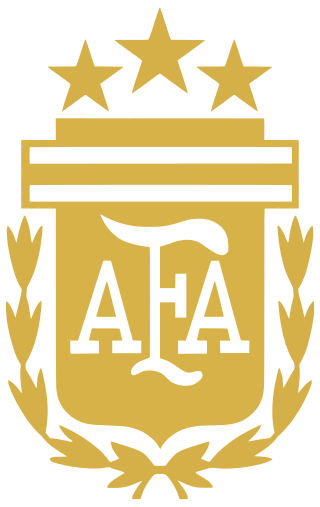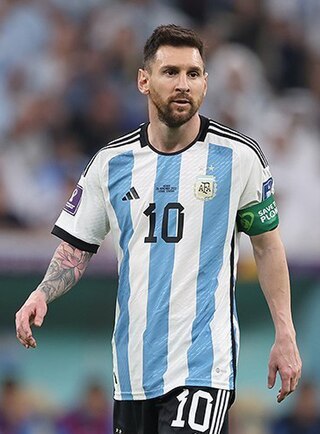
Diego Armando Maradona was an Argentine professional football player and manager. Widely regarded as one of the greatest players in the history of the sport, he was one of the two joint winners of the FIFA Player of the 20th Century award.

The Argentina national football team represents Argentina in men's international football and is administered by the Argentine Football Association, the governing body for football in Argentina.

Gabriel Omar Batistuta is an Argentine former professional footballer. During his playing career, Batistuta was nicknamed Batigol as well as El Ángel Gabriel. Regarded as one of the best strikers of his generation, he was named by Pelé in the FIFA 100 list of the world's greatest living players in 2004.

Club Atlético Newell's Old Boys is an Argentine sports club based in Rosario, Santa Fe. The club was founded on 3 November 1903, and is named after Isaac Newell of the English county of Kent, one of the pioneers of Argentine football.

Ricardo Enrique Bochini is an Argentine former professional footballer who played as an attacking midfielder. He is nicknamed El Bocha. He spent his nearly twenty-year professional career at club Independiente, becoming one of the most emblematic players and the greatest idol in the history of the club. Bochini was a childhood idol of Argentine footballer Diego Maradona.

Lionel Andrés "Leo" Messi is an Argentine professional footballer who plays as a forward for and captains both Major League Soccer club Inter Miami and the Argentina national team. Widely regarded as one of the greatest players of all time, Messi has won a record eight Ballon d'Or awards, a record six European Golden Shoes, and was named the world's best player for a record eight times by FIFA. Until leaving the club in 2021, he had spent his entire professional career with Barcelona, where he won a club-record 34 trophies, including ten La Liga titles, seven Copa del Rey titles, and the UEFA Champions League four times. With his country, he won the 2021 Copa América and the 2022 FIFA World Cup. A prolific goalscorer and creative playmaker, Messi holds the records for most goals in La Liga (474), most hat-tricks in La Liga (36) and the UEFA Champions League (eight), and most assists in La Liga (192) and the Copa América (17). He also has the most international goals by a South American male (106). Messi has scored over 800 senior career goals for club and country, and has the most goals by a player for a single club (672).

Estadio Diego Armando Maradona is a football stadium located in the district of Villa General Mitre, Buenos Aires, Argentina. It is the home venue of club Argentinos Juniors, and has a capacity of 22,023 spectators.

The Argentina–Brazil football rivalry is a sports rivalry between the national football teams of the two countries and their respective sets of fans. Games between the two teams are often marked by notable and controversial incidents. The rivalry has also been referred to as the Battle of the Americas or the Superclassic of the Americas. FIFA has described it as the "essence of football rivalry". CNN ranked it second on their top 10 list of international football rivalries—only below the older England–Scotland football rivalry.

Alejandro Javier Sabella was an Argentine football player and manager. Born in Buenos Aires, he began his playing career with River Plate in his home country before moving to England in 1978 to play for Sheffield United. He then had a spell with another English side, Leeds United, before returning to South America and representing Estudiantes, Grêmio, Ferro Carril Oeste and Irapuato.

Barracas is a barrio, or district, in the southeast part of the city of Buenos Aires, Argentina. It is located between the railroad of Ferrocarril General Manuel Belgrano and the Riachuelo River, and the streets Regimiento de Patricios, Defensa, Caseros, Vélez Sársfield, Amancio Alcorta, Lafayette, and Lavardén. The name Barracas comes from the word barraca, which refers to a temporary construction of houses using rudimentary materials.
The Olimpia Awards are Argentine sports awards given annually by the Círculo de Periodistas Deportivos since 1954. An Olimpia de Plata is awarded to the outstanding performer in 41 sports.

Marcelo Fabián Espina Barrano is a retired Argentine football midfielder. He played for a number of clubs in Argentina and Chile and represented the Argentina national football team. In the present, he is a soccer match analyst at ESPN South America.

"The hand of God" was a goal scored by Argentine footballer Diego Maradona during the Argentina v England quarter finals match of the 1986 FIFA World Cup. The goal was illegal under association football rules because Maradona used his hand to score. The referees did not have a clear view of the play and allowed the goal to stand. The goal gave Argentina a 1–0 lead. Argentina went on to win 2–1, with Maradona scoring a second goal known as the "Goal of the Century", en route to claiming the World Cup.

New Maradona or New Diego was a title given by the press and public to promising Argentine football players in reference to Diego Maradona as a benchmark. Since Maradona retired, people had been anticipating someone to lead the Argentina national team to a World Cup final, like Maradona did in 1986 and 1990. As a consequence, very talented youngsters were quickly labeled as the New Maradona, sometimes without any similarity in playing style. The New Maradonas were predominantly players in attacking or advanced playmaking roles — forwards, wingers, or attacking midfielders. The term gradually fell out of use after Lionel Messi successfully managed to lead Argentina to World Cup finals in 2014 and 2022, winning it in the latter, arguably emulating and surpassing Maradona to become the most successful Argentine footballer ever.

This is a record of Argentina's results at the FIFA World Cup. Argentina is one of the most successful teams in the tournament's history, having won three World Cups: in 1978, 1986, and 2022. Argentina has also been runner-up three times: in 1930, 1990 and 2014. In 18 World Cup tournaments, Argentina has 47 victories in 88 matches. The team was present in all but four of the World Cups, being behind only Brazil and Germany in number of appearances.
This is a list of statistical records for the Argentina national football team.
The history of the Argentina national football team begins with their first official match, played on 20 July 1902 against Uruguay, a 6–0 win in Paso del Molino, Montevideo. One year before, There had been a precedent when representatives from both sides met in a match also in Montevideo, although it was not organised by any association and therefore is not considered official.
Football is the most popular sport, both in terms of participants and spectators, in the Argentine capital of Buenos Aires. Buenos Aires has one of the highest concentration of football teams of any city in the world, with many of its teams playing in the top tier Primera División. This has led to the development of several rivalries within the city, contested as "derbys" when the regular league schedule brings these teams together, such as the Superclásico between Boca Juniors and River Plate – deemed one of the "50 sporting things you must do before you die" by The Observer. Other major clubs include Vélez Sarsfield, Ferro Carril Oeste and Argentinos Juniors.

The Argentina–Uruguay football rivalry, also known as Clásico del Río de la Plata, is a highly competitive sports rivalry that exists between the Argentine and Uruguayan national football teams and their respective set of fans. Considered by football journalists and fans alike as one of the most important rivalries in the sport, the derby is also the most played in football history. According to FIFA records, 197 official matches have been played to date, the first of which was played on 20 July 1902, in which both teams played the first international match outside the United Kingdom in Uruguay, with Argentina winning by 6–0.

















